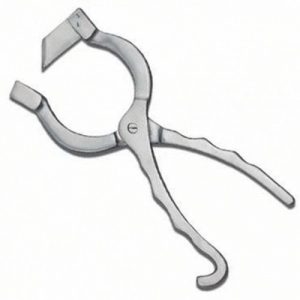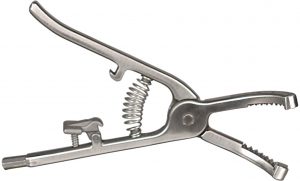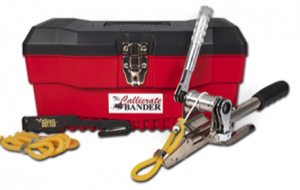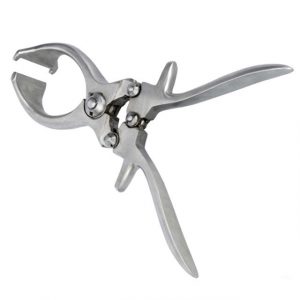FA youngstock processing
Bovine castration
Overview
Calves can be castrated at any age but are typically castrated within the first week to first few months of life and early castration is recommended. Newborn calves are easier to restrain and handle and experience less bleeding and lower infection rates. Production parameters such as weight gain are also minimally affected when surgery is performed in the younger calves compared to later in life.
Generally producers and owners castrate their calves. Rarely would a vet be called to perform routine castration but vets may be asked to train new owners or to work with rescue groups. General types of castrations and tools are bloodless (burdizzos, banding) or open (blades).
Open castration

Open castration is more common in northern climates and in colder weather. Fly control is necessary and is harder to achieve in the south. After the testicles are pushed up toward the body, either a scalpel blade may be used to remove the bottom third of the scrotum or a special knife (Newbury knife; left) can be used to open the scrotum down both sides. The newbury knife has a guarded blade for extra safety.
Once the testicles are exposed, they may be removed by manually pulling the cord apart (hold the proximal end well and pull steadily on the testicle until the cord breaks) or by using tools. With the pull method, the trauma causes vascular spasm and vessel clotting. This works best in young animals (<3 mo old) with smaller cords and arteries).Twisting or tearing of vessels stimulates the clotting cascade; cutting doesn’t.

The Henderson tool was developed in cattle and twists the cord to create trauma (releases clotting factors) and hemostasis.
Emasculators or ligatures can also be used in large animals.
Youtube video castration using newbury knife
Youtube video castration with Henderson tool
Bloodless castration is created by crushing the cord vessels, leading to ischemic necrosis of the testicle and skin. This is preferred when flies are more of a nuisance and fly strike (maggots) a greater risk.
Banding
After the testicles are pushed down into the scrotum n elastrator tool is used to stretch the rubber rings so they can be passed over the bottom of the scrotum and released on the cord above both testicles. The scrotum and testicles fall off in 30-40 days. Elastrator bands can lead to tetanus and seem to have the most significant effects on the calves in terms of pain and discomfort. They should not be used on older calves as the crush may not be sufficient to cause ischemia. It is also easy to miss a testicle that slides up and out of the way, leading to incomplete castration. The Callicrate bander operates on similar principles to the elastrator tool but can be used on adult bulls. Generally, banding in older animals should be avoided due to the prolonged discomfort associated unless analgesics are used post-banding. This may be needed when the risk related to open incisions is high. The literature suggests most pain and inflammation occurs within the first few days after banding.


N
New: LidoBands are bands that release lidocaine into the region applied. These do seem to provide additional analgesia.
Burdizzo
The Burdizzo emasculatome also crushes the cord without cutting the skin. With this technique, the testicles atrophy but the scrotum does not slough. The clamp is placed on each cord individually and at different levels. The staggered crush saves blood supply to the skin while still damaging the cord to each testicle. The crush should be held for ~10 seconds on each side. The Burdizzo is used on calves with slightly larger cords that can be readily palpated and identified.

Analgesia and anesthesia
Local anesthesia using lidocaine (testicular, cord blocks or epidurals) mitigates the distress of the procedure but does not prevent the cortisol response or postoperative behavior changes. Preoperative NSAIDs improve the cortisol response but are not sufficient pain control for the procedure. The combination is ideal- give both preop NSAIDs and use local blocks. Meloxicam added to the milk ration at least 3 hours prior to castration makes a noticeable difference. If the procedures are to be done early in the morning, the drug can be given the night before. Cattle are not super sensitive to lidocaine (high dose is ~ 8 mg/kg) but younger animals are less able to metabolize lidocaine so some caution with larger volumes is warranted.
Key Takeaways
Bovine castration is best done in young animals with preoperative analgesia (NSAID) and local blocks
Open (surgical) or closed (crushing) methods may be used, with the recommended techniques varying by age.
Resources
Miesner and Anderson. Surgical Management of Common Disorders of Feedlot Calves. Vet Clin Food Anim 31 (2015) 407–424
JF Coetzee. Assessment and Management of Pain Associated with Castration in Cattle. Vet Clin Food Anim 29 (2013) 75–101
JM Ewoldt. Surgery of the scrotum, Vet Clin Food Anim 24 (2008):253–266
Castration of calves fact sheet, Ontario 2007 – useful for age ranges and complications
Does UK licensed NSAID administration reduce signs of postoperative pain in calves castrated without local anaesthesia? Veterinary Evidence, July 2021
- good review of other studies
Barrell/Knauer Yak intratesticular block video
Using a callicrate bander to remove a mass

